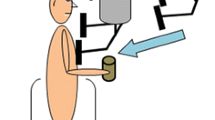Abstract.
Triggering of balance corrections may depend on both leg and trunk proprioceptive inputs. To study this issue and to determine how a total proprioceptive loss in the legs (ToLPL) would affect postural reactions in different directions, we investigated the postural control of a patient with a long-standing dorsal root ganglionopathy. This patient had absent stretch reflexes at the ankle and knee joints, delayed reflexes at the hips, but normal muscle strength. Postural control was probed with support-surface movements driven by two different experimental protocols. The first protocol concentrated on leg muscle responses by varying ankle inputs during pitch plane perturbations. The second protocol focussed on the directional sensitivity of upper body responses using combined roll and pitch tilt perturbations. For both protocols, identical techniques were used to record ankle torques, angular velocities of the upper legs and trunk, and surface EMG from leg, hip and trunk muscles. For the first protocol, pitch plane stance perturbations with three different ankle inputs were imposed by a movable support surface. A simultaneous 4-cm rearward translation and 4-deg toe-up rotation produced an 80-deg/s "enhanced ankle input", a simple toe-up rotation gave a 40-deg/s "normal" ankle input and a simultaneous 4-cm rearward translation and 4-deg "toe-down" rotation yielding a 0-deg/s "nulled ankle input". Responses in the ToLPL patient were compared to those of healthy controls and those of patients with lower-leg proprioceptive loss (LLPL). Following normal and enhanced ankle input perturbations, stretch reflexes were absent in ankle and knee joint muscles of the ToLPL patient. Balance correcting responses in the lower legs were diminished and delayed by some 45 ms. In quadriceps, balance-correcting responses were larger than normal, peaked earlier and were not delayed. During the nulled ankle input condition, the ankle muscle responses in the ToLPL patient were again diminished and delayed by 40 ms with respect to both normal subjects and LLPL patients. However, the ToLPL patient again generated an earlier, larger, balance correcting response in quadriceps. For the second protocol, combinations of roll and pitch perturbations were also delivered by a moving support surface. The amplitude was 7.5 deg at 50 deg/s. Eight different directions were applied randomly (pure "toes down", pure "toes up" and directions at 45-deg intervals of roll). As with the first protocol pre-stimulus background muscle activity was excessive in all trunk and most leg muscles. Responses to roll tilt produced several striking changes from normal in the ToLPL patient. First reflexes in gluteus medius were delayed. Second, the trunk roll which commences around 30 ms in normals was in the opposite direction. This roll was accompanied by oppositely directed stretch reflexes in paraspinal muscles. Third, directional sensitivity of balance corrections was far more roll oriented in leg and trunk muscles. Fourth, some tilt directions caused a deactivation response of background activity. This "deactivation strategy" strongly contrasted with the strategy of controls who had low pre-stimulus background activity and activated responses around 100 ms to correct postural instability. These findings provide new insights into the generation of pitch and roll plane directed balance corrections based on the interaction of proprioceptive trigger signals from the ankles, knees and hips. Without proprioceptive input from the ankle and knee, ankle muscle responses are delayed but not absent. Upper leg and trunk responses are not delayed. This suggests that most, if not all, lower leg balance correcting responses are triggered by hip and, possibly, trunk proprioceptive inputs. When leg proprioceptive input is absent, balance correcting responses lose pitch plane sensitivity. The solution used by the patient to overcome these deficits was to markedly raise background muscle activity levels, presumably to provide a stiffer body structure. The lack of trunk flexibility and lateral instability this produced for roll tilts was offset by the ability to compensate by using a hitherto not described "deactivation response" strategy. The patient had a clinical picture usually described as "deafferented"; yet our roll tilt perturbations revealed delayed reflex responses in hip muscles. With vestibulospinal and neck-proprioceptive inputs, these responses may have helped with the development of compensation processes for the total leg proprioceptive deficit.
Similar content being viewed by others
Author information
Authors and Affiliations
Additional information
Electronic Publication
Rights and permissions
About this article
Cite this article
Bloem, .B., Allum, J., Carpenter, .M. et al. Triggering of balance corrections and compensatory strategies in a patient with total leg proprioceptive loss. Exp Brain Res 142, 91–107 (2002). https://doi.org/10.1007/s00221-001-0926-3
Received:
Accepted:
Issue Date:
DOI: https://doi.org/10.1007/s00221-001-0926-3




